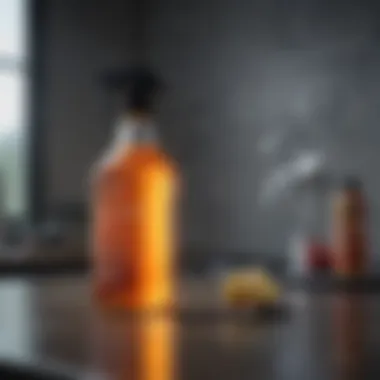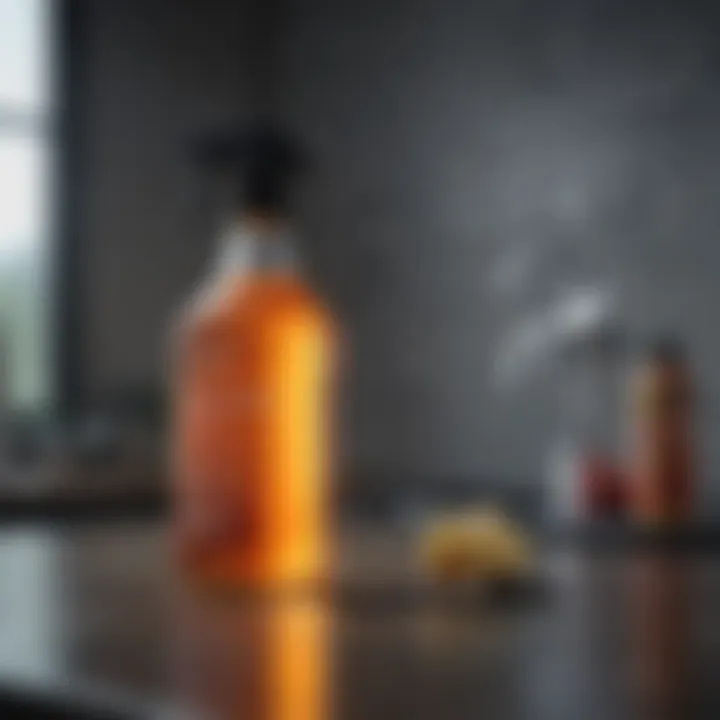Understanding the Disinfecting Power of Vinegar


Intro
Vinegar has been used for centuries, popular in both culinary and household contexts. Its potential as a disinfectant is often overshadowed by more heavily marketed products. The idea that vinegar can effectively sanitize surfaces raises interest among homeowners and design enthusiasts alike. Understanding its disinfecting power requires examining the specific conditions under which it works best.
This article aims to provide a detailed analysis of vinegar's disinfecting properties. By focusing on various factors such as concentration and temperature, the effectiveness of vinegar as a cleaning agent can be better understood. This knowledge is crucial for those seeking natural and eco-friendly alternatives for maintaining cleanliness in their spaces.
The Science Behind Vinegar
Vinegar is primarily acetic acid, with typical concentrations around 5-7%. It functions by penetrating the cell walls of microorganisms such as bacteria and viruses, disrupting their internal processes. The acidity creates an environment that is inhospitable for many pathogens. However, the effectiveness can vary based on several aspects.
Concentration Matters
Different concentrations of vinegar yield different outcomes. A higher concentration of acetic acid tends to exhibit more potent disinfecting properties. For instance, cleaning vinegar, which has about 20% acetic acid, has been found to be significantly more effective against specific types of bacteria compared to standard household vinegar.
Optimal Temperature Conditions
Temperature also plays a critical role in the disinfection process. Vinegar functions more effectively at warmer temperatures. A range between 130°F to 140°F promotes better disinfection, as heat enhances the penetration of molecules into microbial cells.
The Role of Contact Time
Contact time is another essential factor. Simply applying vinegar to a surface may not be sufficient; it requires an adequate amount of time to act on the pathogens. Best practice recommends letting vinegar sit on a surface for at least 10-15 minutes before wiping it away. This ensures the acetic acid has time to disrupt microorganisms effectively.
Practical Applications of Vinegar as a Disinfectant
For homeowners and design enthusiasts, using vinegar as a cleaner presents a viable option. Understanding its properties allows for practical applications in daily life. Here are some tips:
- Use cleaning vinegar for more challenging disinfecting tasks.
- Heat the vinegar before application to enhance effectiveness.
- Allow the vinegar to sit for the recommended time on surfaces, especially in kitchens and bathrooms.
"Vinegar is not just a cooking ingredient; it is also a valuable tool for maintaining a clean and safe environment."
Preface to Vinegar as a Disinfectant
Vinegar has been recognized for centuries as a versatile substance with various uses, particularly in cleaning and disinfecting. This section explores why it is relevant to understand vinegar as a disinfectant in today’s world, where eco-friendliness and safety are paramount. People are increasingly looking for solutions that minimize exposure to harsh chemicals. Vinegar, being derived from natural sources, presents a compelling alternative. It not only removes dirt and grime but can also kill certain pathogens. Therefore, knowing its properties, applications, and effectiveness is essential for homeowners and cleaning enthusiasts alike.
Historical Use of Vinegar
Historically, vinegar has been utilized in various forms throughout human civilization. Ancient Egyptians used it in embalming processes as a disinfectant. The Greeks also employed vinegar in the preservation of food and cleaning. Fast forward to the Middle Ages; vinegar was a key ingredient in remedies against plagues and infections. Its antiseptic qualities were widely recognized. People applied it to wounds to prevent infection, showing how its use was rooted in practices aimed at improving hygiene and health.
These historical applications set a foundation for understanding how vinegar came to be viewed as a reliable cleaning agent. Its long-standing tradition has led to cultural variations in use, and many traditional practices are still relevant today. This historical context is significant as it demonstrates knowledge passed through generations, which helps reinforce vinegar’s legitimacy as a disinfectant in modern settings.
Modern Applications in Cleaning
In recent years, the popularity of vinegar in cleaning has surged. This trend is linked to a growing awareness of environmental issues and a desire for healthier living conditions. Many households now turn to white distilled vinegar or apple cider vinegar for various cleaning tasks. It is effective in removing odors, breaking down mineral deposits, and cleaning glass surfaces.
Moreover, vinegar serves a multifaceted role in cleaning routines. From kitchen surfaces to bathroom fixtures, its uses are diverse. Additionally, it can act as a mild disinfectant, although its efficacy varies with concentrations and specific pathogens.
As a modern cleaning solution, vinegar stands out by being inexpensive and accessible. Many users appreciate not only its effectiveness but also its natural origin, aligning with the current trend focused on sustainability. With these characteristics, vinegar continues to be a preferred choice for many seeking to reduce their reliance on synthetic chemicals in home cleaning.
Chemical Composition of Vinegar
The chemical composition of vinegar is fundamental to understanding its disinfecting properties. Mainly composed of acetic acid, vinegar has been used for centuries as a cleaning agent and preservative. Its simplicity as a natural product gives it a unique appeal compared to commercial disinfectants. Knowing what makes up vinegar helps consumers make informed choices about its applications and effectiveness.


Acetic Acid Concentration
The concentration of acetic acid in vinegar is a crucial factor influencing its ability to disinfect surfaces. Typically, household vinegar has an acetic acid concentration of about 5% to 7%. This level is sufficient for many cleaning tasks. Higher concentrations, like those found in cleaning vinegars, can reach up to 20% acetic acid, which significantly enhances its disinfecting power.
One must consider that as the concentration increases, so does the potential for surface damage. For instance, a 20% solution might cause etching on sensitive surfaces like marble or granite. Therefore, understanding the acetic acid level is vital when selecting vinegar for specific cleaning needs.
Vinegar’s acetic acid content enables it to disrupt the cellular structure of bacteria, leading to their destruction. Therefore, its concentration directly correlates with its effectiveness as a disinfectant.
Additional Ingredients in Vinegar
Aside from acetic acid, vinegar can contain various other constituents depending on its type and processing method. For instance, apple cider vinegar, white vinegar, and balsamic vinegar have different flavor profiles and slightly varying compositions but fundamentally contain similar amounts of acetic acid. Other organic compounds can give each vinegar its distinct characteristics, but they should be scrutinized for their effect on cleanliness.
Common additional ingredients may include sugar, flavoring agents, and preservatives, especially in flavored vinegars. These extra components can affect the cleaning effectiveness of vinegar. For example, sugars may leave residues on the surfaces, which can attract more dirt or bacteria later.
When using vinegar for disinfecting, it is essential to choose the right type, keeping in mind what additives may be present. This awareness ensures optimal cleaning without unintended consequences.
Mechanisms of Disinfection
The mechanisms of disinfection help clarify how vinegar functions as a cleaning agent. Understanding these mechanisms gives insight into the effectiveness of vinegar against various pathogens. This section covers crucial aspects, including how acetic acid, the primary component of vinegar, works to kill microorganisms and the significance of pH levels in the disinfection process.
How Acetic Acid Kills Pathogens
Acetic acid is recognized for its ability to destroy bacteria, fungi, and some viruses. When vinegar is applied to a surface, the acetic acid penetrates the cell walls of pathogens. Once inside, it disrupts cellular processes, leading to cell death. This process is often described as a function of osmosis and the alteration of the internal pH of the microbial cells. The acetic acid interferes with enzyme function, thus inhibiting the microorganism's ability to metabolize and reproduce.
Research suggests that higher concentrations of acetic acid can lead to more effective disinfection. Vinegar typically contains 5% acetic acid, but higher concentrations are available and may be more effective in specific situations.
For common household pathogens, vinegar can serve as a useful disinfectant. However, it may not be sufficient against all viruses, especially those that have a lipid envelope, which requires stronger solutions.
Understanding pH Levels and Their Effects
The pH level is critical in disinfecting processes. Vinegar has a naturally acidic pH, typically around 2 to 3. This acidity plays a crucial role in disinfection. Many pathogens thrive in neutral to slightly alkaline environments, therefore, the acidic condition created by vinegar can inhibit their growth and activity.
In general:
- Lower pH levels enhance the effectiveness of acetic acid against microbes.
- The increased acidity can denature proteins within microorganisms, effectively rendering them inactive.
- Vinegar is less effective as a disinfectant in environments that are neutral or alkaline, which can neutralize its acidic properties.
This underscores the importance of optimal pH settings in achieving effective disinfection with vinegar.
The understanding of mechanisms through which acetic acid operates is not merely academic. It can significantly influence how one uses vinegar for disinfecting purposes, shaping choices on application methods. This lays a foundation for comprehending vinegar’s role in both eco-friendly cleaning practices and its limitations.
Factors Influencing Disinfection Time
Understanding the factors that influence disinfection time is crucial in maximizing the effectiveness of vinegar as a disinfectant. Numerous elements affect how well and how fast vinegar can eliminate pathogens on various surfaces. By analyzing these factors, homeowners and cleaning enthusiasts can make informed decisions regarding the use of vinegar in their cleaning routines. The primary factors include the type and material of the surface, environmental conditions, and the concentration of vinegar used.
Surface Type and Material
The surface type and material play a vital role in disinfection time. Different materials interact with vinegar uniquely. For instance, non-porous surfaces such as glass or metal tend to allow vinegar to act more effectively compared to porous surfaces such as wood or fabric. The absorption characteristics of porous materials can trap and shelter bacteria or viruses, making it more difficult for vinegar to penetrate and disinfect.
Also, the texture of a surface can affect how well vinegar adheres, which is important for effective disinfection. Smooth surfaces allow for quicker contact with vinegar, while textured or uneven surfaces can hinder the process.
"Understanding surface materials and their behavior with vinegar can lead to more effective cleaning strategies."
Temperature and Environmental Conditions


Temperature is another significant factor influencing disinfection time. Vinegar generally performs better at warmer temperatures. Higher temperatures can enhance the activity of acetic acid in vinegar, accelerating its disinfecting action. Ideal temperatures for vinegar disinfection range from 50 to 70 degrees Fahrenheit. If the environment is too cold, the effectiveness of vinegar may decrease.
Humidity can also impact disinfecting properties. High humidity might create a favorable environment for pathogens, potentially extending the time vinegar requires to disinfect effectively. Being aware of your cleaning environment can greatly affect the outcomes of using vinegar as a disinfectant.
Concentration of Vinegar Used
The concentration of acetic acid in vinegar is directly correlated with its disinfecting ability. Household vinegar typically contains about 5% acetic acid. While this concentration can kill many pathogens, higher concentrations can improve effectiveness. Many disinfecting tasks may benefit from using vinegar with a higher concentration, such as 10% to 20%. However, higher concentrations can also lead to a greater potential for surface damage.
Using an appropriate concentration for each cleaning scenario is essential. Factors such as the type of surface, the level of contamination, and safety considerations should be taken into account. Thus, adjusting vinegar concentration based on specific needs is highly recommended for optimal disinfection results.
Recommended Contact Time for Effective Disinfection
Understanding the recommended contact time for vinegar as a disinfectant is crucial in ensuring its effectiveness. Contact time refers to the duration vinegar needs to be in contact with a surface to kill pathogens effectively. Many consumers may underestimate this time and, as a result, may not achieve the desired sanitation level. Lack of proper contact time can lead to ineffective disinfection, allowing harmful microorganisms to survive.
Factors such as the type of surface, the concentration of vinegar, and the pathogenic load influence the required contact time. General guidelines suggest that vinegar should remain on a surface for at least 10 minutes for effective disinfection. However, longer contact times may be necessary depending on specific cleaning scenarios. Proper understanding of these guidelines can help maximize vinegar’s disinfecting properties while maintaining a safe environment.
Guidelines for General Disinfection
When using vinegar for routine disinfection, follow these essential guidelines:
- Use the Right Concentration: For effective disinfection, a concentration of at least 5% acetic acid is recommended. This common level is present in most household vinegars.
- Ensure Surface Cleanliness: Before applying vinegar, clean the surface to remove dirt and debris. This step allows the acetic acid to penetrate more effectively.
- Timing is Key: As mentioned, aim for a minimum contact time of 10 to 15 minutes. This duration is critical for killing most germs and bacteria located on hard surfaces.
- Wipe or Rinse if Needed: After the contact time has passed, you may wipe the surface with a clean cloth or rinse it with water to remove any residual vinegar, especially in food preparations areas.
Special Considerations for Different Surfaces
Different surfaces may have varying requirements for effective disinfection with vinegar. Here are some considerations:
- Wood Surfaces: When disinfecting wood, it's essential to limit moisture. Vinegar may need shorter contact times, around 5 to 10 minutes, to avoid damaging the wood's finish.
- Glass and Mirrors: For glass, longer contact times may not be beneficial, but a spray of vinegar can help with streaks if wiped off after approximately 5 minutes.
- High-Touch Areas: In places with high pathogen loads, like doorknobs or light switches, extending the contact time to 15 minutes can provide added protection.
- Fabric or Upholstery: Depending on the fabric, vinegar can also disinfect, but it is best to test a small area first. Keep the fabric damp with vinegar for about 15 minutes.
In summary, ensuring adequate contact time tailored to the type of surface and the cleaning scenario is key to leveraging vinegar’s disinfecting properties effectively. By following these guidelines and taking special considerations into account, users can achieve a cleaner and safer environment utilizing a natural and valuable resource.
Common Misconceptions About Vinegar as a Disinfectant
Vinegar has often been touted as a natural disinfectant. However, its effectiveness is sometimes misunderstood. It is crucial to clarify these misconceptions for informed decision-making regarding cleaning protocols. Misrepresentation of vinegar’s capabilities might lead to inadequate cleaning practices or the dismissal of its benefits.
Effectiveness Against Viruses
One of the primary misconceptions is that vinegar can effectively eliminate all viruses. While vinegar, particularly the acetic acid within it, can kill some pathogens, it is not universally effective against viruses. Research indicates that vinegar can deactivate certain bacteria and fungi but has limited efficacy against viral strains such as Norovirus and Influenza.
The concentration and type of vinegar also matter. For instance, dilute solutions may lack the potency required to combat more resilient pathogens. Thus, relying solely on vinegar for virus disinfection can be misleading. It is vital to consider supplemental methods for virus resolution.
Comparison with Commercial Disinfectants
The comparison of vinegar to commercial disinfectants is another area rife with confusion. Many believe that vinegar is a direct substitute for these products, primarily due to its natural origin. While some commercial disinfectants are harsh chemicals, they are formulated to achieve a higher disinfecting capability. This efficacy is often supported by rigorous testing and compliance with safety standards.
For example, bleach-based cleaners and products containing quaternary ammonium compounds typically show far superior virus-killing effects. Therefore, while vinegar is undeniably an eco-friendly choice, it should not be viewed as a catch-all solution. It’s best to use vinegar in conjunction with other methods for optimal results.
Proper cleaning does not solely depend on one product but should be a part of a multifaceted approach for effective disinfection.
Best Practices for Using Vinegar as a Disinfectant
Understanding how to utilize vinegar effectively as a disinfectant is crucial for those looking for natural cleaning solutions. Vinegar, particularly white vinegar with a high concentration of acetic acid, can be an effective agent against many pathogens. However, to maximize its disinfecting ability, one must follow best practices that consider dilution ratios, application techniques, and the nature of the surfaces being cleaned. These practices ensure that vinegar performs optimally while maintaining safety and reducing the risk of potential damage to surfaces.
Dilution Ratios for Various Applications


When using vinegar to disinfect, it is essential to adhere to proper dilution ratios. The efficacy of acetic acid is most pronounced at certain concentrations. For general cleaning and disinfecting, a solution of vinegar diluted with water in a 1:1 ratio is often recommended. This means mixing equal parts of vinegar and water can provide a balance of effectiveness without being overly abrasive.
In cases where stronger disinfectant properties are needed, a higher concentration of vinegar may be employed. For tough stains or greasy surfaces, a ratio of two parts vinegar to one part water can enhance cleaning effectiveness. In contrast, for sensitive or finished surfaces, it might be prudent to use a dilution of one part vinegar to three parts water to avoid damage.
Understanding the specific needs of each task will help in choosing the right dilution ratio. Here are some common dilution ratios for different applications:
- General surface cleaning: 1:1 (vinegar: water)
- Tough stains: 2:1 (vinegar: water)
- Sensitive surfaces: 1:3 (vinegar: water)
Application Techniques for Maximum Efficacy
Application techniques play a significant role in the effectiveness of vinegar as a disinfectant. Simply spraying a solution may not ensure comprehensive disinfection. Here are some recommended techniques:
- Spray and Dwell: Spray the diluted vinegar solution onto the surface and allow it to sit for several minutes. This dwell time is essential for effective pathogen kill. It is generally advised to let the solution sit for at least five minutes before wiping it away.
- Use a Clean Cloth or Sponge: After letting the vinegar solution dwell, use a clean cloth or sponge to wipe the surface. This helps remove dirt and pathogens. Ensure that the cloth or sponge is clean to avoid re-contaminating the surface.
- Target High-Touch Areas: Focus on high-touch surfaces like doorknobs, light switches, and counter tops. Regular application of vinegar can reduce the concentration of germs on these surfaces over time.
- Proper Storage: Store the vinegar solution in a cool, dark place in a labeled bottle. This keeps the solution effective and prevents confusion with other household products.
In summary, adopting these best practices can greatly enhance the disinfecting power of vinegar. Employing the right dilution ratios and application techniques ensures that vinegar works efficiently while remaining safe for household use.
Regulatory Considerations
The topic of regulatory considerations is vital for understanding the disinfecting power of vinegar. As consumers become increasingly aware of what they use in their homes, the scrutiny over cleaning products is growing. This trend makes it essential for all household cleaners, including vinegar, to meet specific standards that ensure safety and effectiveness.
Safety Standards for Household Products
Safety standards are the guidelines that products must follow to guarantee they are safe for consumer use. For vinegar to be recognized as a disinfectant, it must meet these safety requirements. Organizations such as the Environmental Protection Agency (EPA) in the United States regulate household products, ensuring they are safe when used as directed.
In the context of vinegar:
- Concentration of Acetic Acid: The strength of vinegar plays a significant role in its classification as a disinfectant. Most household vinegar contains 5-7% acetic acid, which can effectively kill certain bacteria. Higher concentrations are often used in industrial settings and should adhere to stricter guidelines.
- Non-Toxic Nature: One of the benefits of using vinegar is its non-toxic profile. This factor makes it more aligned with regulations that prioritize safety in homes, especially around children and pets.
Label Transparency and Consumer Awareness
Label transparency is crucial for consumer trust and informed decision-making. As a disinfectant, vinegar should have clear labeling that informs users of its effectiveness, recommended uses, and any limitations.
Key points regarding label transparency include:
- Ingredient Disclosure: Consumers have the right to know what ingredients are in the cleaning products they use. Vinegar is relatively straightforward, usually just containing water and acetic acid. Clear labeling helps in building trust.
- Usage Instructions and Safety Information: Labels must provide adequate instructions for use, including any specific recommendations for contact times and surface types. This information is essential to maximize the disinfecting power of vinegar.
- Compliance Indications: Labels may also indicate compliance with relevant safety standards or certifications, providing consumers with added assurance.
Effective communication through labels fosters consumer awareness and encourages responsible use of cleaning products, including vinegar.
In summary, both safety standards and label transparency play a significant role in the effectiveness and public perception of vinegar as a disinfectant. Consumers are better equipped to make informed choices when these aspects are regulated and clearly presented.
Ending: Balancing Vinegar’s Benefits and Limitations
Vinegar possesses unique properties that make it a popular choice for cleaning and disinfecting. However, it is essential to overview both its strengths and limitations to fully understand its place as a disinfectant. The effectiveness of vinegar is largely derived from its acetic acid content, which can kill certain types of pathogens. Nevertheless, the concentration of vinegar, type of surface, and contact time can greatly influence its efficiency.
Final Thoughts on Vinegar’s Efficacy
It is clear that vinegar can be an effective disinfectant for everyday use, particularly against bacteria. Its natural origin and non-toxic profile appeal to many who seek alternatives to harsh chemicals. Yet, users must approach vinegar with realistic expectations. While certain strains of viruses and bacteria can be mitigated, vinegar may not be suitable for all disinfection demands. In areas requiring stringent sterilization, such as healthcare settings, professional-grade disinfectants may still prove superior.
Overall, vinegar's efficacy is contingent on specific factors, including the degree of contamination and the environment. It serves well in households, where minor disinfections are common. Homeowners and cleaning enthusiasts can appreciate its utility, but they should remain cognizant of its limits.
Recommendations for Eco-Friendly Cleaning Solutions
For those who prefer to minimize their environmental footprint, vinegar is a valuable option among eco-friendly cleaning solutions. It's wise to consider several practices to maximize its effectiveness:
- Combine vinegar with baking soda: This mixture can enhance cleaning power for specific stains and odors.
- Use distilled white vinegar: This version typically contains a higher acetic acid percentage, improving disinfection potential compared to other types.
- Incorporate essential oils: Adding oils like tea tree or lavender can provide additional antimicrobial properties and pleasant scent.
Moreover, avoiding chemical-laden products supports sustainability. Vinegar contributes to a healthier indoor environment by reducing exposure to volatile organic compounds (VOCs). For anyone interested in maintaining an eco-conscious home, adopting vinegar as a cleaning agent yields not just practical benefits but also a commitment to healthier living.
"Nature provides many cleaning solutions. Vinegar exemplifies how simple ingredients can achieve effective results."















